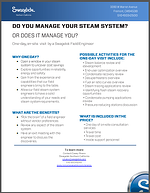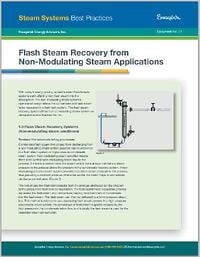Share this
Steam Systems Best Practice: Flash Steam Recovery, Part 2
by Jeff Hopkins on 7/22/15 7:00 AM
Flash steam recovery for non-modulating applications, a flash tank
We've written previously about flash steam recovery in modulating applications. Today we tackle the same general topic of steam recovery, but for non-modulating applications.
"Non-modulating" means there is no control valve modulating steam flow to the process. The system provides a constant steam pressure, thus providing a constant pressure differential across the steam traps or condensate discharge control valve.
Examples of non-modulating steam processes include steam tracing, drip leg steam traps, unit heaters, process heaters, reboilers and corrugators.
The non-modulating steam system’s operational design allows the condensate and flash steam to be recovered in a flash tank system. The flash tank is used to:
• Separate condensate and flash steam
• Control the flashing process
• Allow enough space for flash steam to be released
• Reduce the velocities of the flash steam to ensure no condensate carryover with the flash steam
Decisions, decisions
Now come the crucial decisions. How big should the flash tank be for a particular system?
Should the tank be mounted vertically or horizontally? What outlet velocities are within an acceptable range? Can your particular setup use a cascade steam system for recovery, or does it need a thermocompressing system?
To reach those answers, you'll need to make some calculations. The first one is to figure out the amount of condensate entering the flash tank. That will be the sum of the steam-consuming capacity of all equipment discharging into the condensate return line that is going to the flash tank. This could be only one component or multiple components.
Next determine the process pressure and flash tank pressure.
Then calculate the condensate that flashes to steam. From there you can size the steam space.
Where can you find the formulas for those calculations? Click here to read the steam system best practice: Flash Steam Recovery from Non-Modulating Steam Applications and download a free, illustrated, five-page PDF of best practices related to flash steam recovery from non-modulating applications with steps to designing a flash tank and detailed examples.
Additional Resources
 |
 |
|
| Plan Your Steam System Success eBook | Steam Systems Engineer Site Visit | |
Share this
- Archive (465)
- Assembly Services (207)
- About (100)
- Seal Support Systems (96)
- Best Practices (88)
- Training Services (74)
- Fittings (51)
- Semiconductor Applications (49)
- Hoses and Flexible Tubing (47)
- Regulators (44)
- Tubing (42)
- Grab Sampling Systems (32)
- Sampling Systems (32)
- Gas Systems (30)
- Services (30)
- Downloads (29)
- Valves (24)
- Application Support (18)
- Orbital Welding (17)
- Case Studies (13)
- Steam Systems (13)
- Frequently Asked Questions (12)
- Tools (12)
- Measurement Devices (7)
- Subsystems (6)
- Thermal Management (6)
- September 2023 (1)
- August 2023 (2)
- June 2023 (1)
- March 2023 (3)
- February 2023 (3)
- January 2023 (4)
- December 2022 (4)
- November 2022 (4)
- October 2022 (4)
- September 2022 (1)
- August 2022 (3)
- July 2022 (2)
- June 2022 (4)
- May 2022 (1)
- April 2022 (2)
- March 2022 (1)
- February 2022 (2)
- January 2022 (3)
- December 2021 (1)
- November 2021 (6)
- October 2021 (6)
- September 2021 (8)
- August 2021 (4)
- July 2021 (3)
- June 2021 (6)
- May 2021 (6)
- April 2021 (7)
- March 2021 (5)
- February 2021 (4)
- January 2021 (6)
- December 2020 (5)
- November 2020 (6)
- October 2020 (6)
- September 2020 (8)
- August 2020 (7)
- July 2020 (8)
- June 2020 (8)
- May 2020 (6)
- April 2020 (9)
- March 2020 (7)
- February 2020 (10)
- January 2020 (21)
- December 2019 (23)
- November 2019 (21)
- October 2019 (22)
- September 2019 (21)
- August 2019 (22)
- July 2019 (23)
- June 2019 (20)
- May 2019 (23)
- April 2019 (22)
- March 2019 (21)
- February 2019 (20)
- January 2019 (21)
- December 2018 (14)
- November 2018 (19)
- October 2018 (23)
- September 2018 (17)
- August 2018 (29)
- July 2018 (11)
- June 2018 (6)
- May 2018 (5)
- April 2018 (4)
- March 2018 (5)
- February 2018 (3)
- January 2018 (3)
- December 2017 (2)
- November 2017 (4)
- October 2017 (3)
- September 2017 (2)
- August 2017 (6)
- July 2017 (4)
- June 2017 (4)
- May 2017 (4)
- April 2017 (3)
- March 2017 (4)
- February 2017 (3)
- January 2017 (3)
- December 2016 (3)
- November 2016 (3)
- October 2016 (3)
- September 2016 (5)
- August 2016 (5)
- July 2016 (4)
- June 2016 (5)
- May 2016 (3)
- April 2016 (4)
- March 2016 (5)
- February 2016 (11)
- January 2016 (1)
- December 2015 (3)
- November 2015 (4)
- October 2015 (3)
- September 2015 (4)
- August 2015 (4)
- July 2015 (8)
- June 2015 (5)
- May 2015 (3)
- April 2015 (4)
- March 2015 (4)
- February 2015 (3)
- January 2015 (4)
- December 2014 (2)
- November 2014 (3)
- October 2014 (4)
- September 2014 (4)
- August 2014 (4)
- July 2014 (5)
- June 2014 (4)
- May 2014 (4)
- April 2014 (5)
- March 2014 (4)
- February 2014 (3)
- January 2014 (4)
- December 2013 (5)
- November 2013 (3)
- October 2013 (4)
- September 2013 (3)
- August 2013 (5)
- July 2013 (5)
- June 2013 (5)
- May 2013 (3)
- April 2013 (6)
- March 2013 (4)
- February 2013 (4)
- January 2013 (8)
- December 2012 (4)
- November 2012 (6)
- October 2012 (6)
- September 2012 (4)
- August 2012 (4)
- July 2012 (4)
- June 2012 (4)

.webp?width=210&height=70&name=StickyLogo%20(5).webp)
